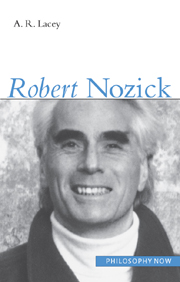Book contents
- Frontmatter
- Contents
- Preface
- 1 Introduction
- 2 Anarchy, State, and Utopia: the moral basis
- 3 Anarchy, State, and Utopia: the political outcome
- 4 The later ethics and politics
- 5 Epistemology
- 6 Rationality
- 7 Metaphysics I: personal identity
- 8 Metaphysics II: explaining existence
- 9 Metaphysics III: free will and retribution
- 10 The meaning of life
- Guide to further reading
- Bibliography
- Index
8 - Metaphysics II: explaining existence
- Frontmatter
- Contents
- Preface
- 1 Introduction
- 2 Anarchy, State, and Utopia: the moral basis
- 3 Anarchy, State, and Utopia: the political outcome
- 4 The later ethics and politics
- 5 Epistemology
- 6 Rationality
- 7 Metaphysics I: personal identity
- 8 Metaphysics II: explaining existence
- 9 Metaphysics III: free will and retribution
- 10 The meaning of life
- Guide to further reading
- Bibliography
- Index
Summary
Introduction: “Why is there something rather than nothing?”
We have seen how Nozick emphasizes explanation as the proper aim of philosophy. This comes to the fore in the title of the second chapter of Philosophical Explanations, “Why Is There Something Rather Than Nothing?”, especially if, as Camacho (1986: 415) comments, this “quickly becomes the somehow different question of the limits of our understanding”, and whether it is possible to explain everything. The question “why is there something rather than nothing?” probably occurs to most people sometimes, but is only rather rarely discussed by philosophers, partly because it is often assumed to be either senseless, or dispensable, or insoluble. It might be thought senseless by someone who thought, as a logical positivist would, that we cannot understand a question unless we know what would count as an answer to it, although it would always be open to us, as a positivist like Schlick would admit, to investigate further this last question (about what would count). The question might be thought dispensable if it were shown that it is a necessary fact that there is something, although this would need to be shown, and even that might not settle the question. I might verify, by going through all 1,000 of them individually, that any six-figure number of the form ABCABC is divisible by 77, and realize that being a mathematical fact this must be necessary, but still ask why.
- Type
- Chapter
- Information
- Robert Nozick , pp. 177 - 187Publisher: Acumen PublishingPrint publication year: 2001



